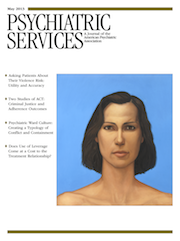The Utility of Patients’ Self-Perceptions of Violence Risk: Consider Asking the Person Who May Know Best
Abstract
Objective
The authors compared the predictive accuracy of two risk assessment methods that are feasible to use in routine clinical settings: brief risk assessment tools and patients’ self-perceptions of risk.
Methods
In 2002–2003, clinical interviewers met with 86 high-risk inpatients with co-occurring mental and substance use disorders (excluding schizophrenia) to carefully elicit the patients’ global rating of their risk of behaving violently and to complete two brief risk assessment tools—the Clinically Feasible Iterative Classification Tree (ICT-CF) and the Modified Screening Tool (MST). Two months after discharge, patients were reinterviewed in the community to assess their involvement in violence.
Results
Patients’ self-perceptions of risk performed quite well in predicting serious violence (area under the curve [AUC]=.74, sensitivity=50%), particularly compared with the ICT-CF (AUC=.59, sensitivity=40%) and the MST (AUC=.66, sensitivity=30%). Self-perceived risk also added significant incremental utility to these tools in predicting violence.
Conclusions
Patients’ self-perceptions hold promise as a method for improving risk assessment in routine clinical settings. Assuming it replicates and generalizes beyond the research context, this finding encourages a shift away from unaided clinical judgment toward a feasible method of risk assessment built on patient collaboration.




